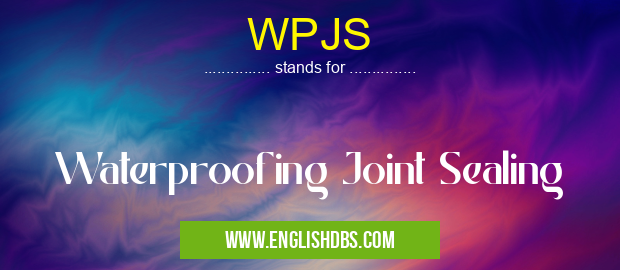What does WPJS mean in CONSTRUCTION
WPJS stands for Waterproofing Joint Sealing. It is a crucial process used in various industries to prevent water penetration and leakage. WPJS is primarily employed in construction and building maintenance to ensure the integrity and durability of structures.

WPJS meaning in Construction in Miscellaneous
WPJS mostly used in an acronym Construction in Category Miscellaneous that means Waterproofing Joint Sealing
Shorthand: WPJS,
Full Form: Waterproofing Joint Sealing
For more information of "Waterproofing Joint Sealing", see the section below.
What is WPJS?
WPJS is the application of specialized materials and techniques to seal joints, gaps, and cracks in structures, primarily to prevent water infiltration. These materials can include sealants, gaskets, and membranes designed to withstand water pressure and exposure to various environmental conditions. WPJS is essential for maintaining the structural integrity and preventing water damage, which can lead to costly repairs and safety hazards.
Importance of WPJS
Effective WPJS provides numerous advantages, including:
- Prevents water damage: WPJS helps protect buildings and structures from water penetration, reducing the risk of mold, mildew, and structural weakening.
- Enhances structural integrity: By sealing joints, WPJS strengthens the overall structure and improves its ability to withstand environmental stresses.
- Reduces maintenance costs: Proper WPJS minimizes the need for costly repairs and maintenance associated with water damage.
- Improves energy efficiency: WPJS can help reduce heat loss and gain, contributing to energy savings.
Applications of WPJS
WPJS is widely used in various construction and maintenance projects, such as:
- Building facades: Sealing joints in exterior walls and windows prevents water infiltration and protects against weather damage.
- Roofing: WPJS is used to seal gaps and joints in roofing systems to prevent leaks and maintain structural integrity.
- Plumbing: WPJS ensures watertight connections in plumbing systems, reducing the risk of leaks and damage.
- Tunnels and underground structures: WPJS is critical for preventing water seepage and maintaining the structural stability of underground spaces.
Essential Questions and Answers on Waterproofing Joint Sealing in "MISCELLANEOUS»CONSTRUCTION"
What is waterproofing joint sealing (WPJS)?
Waterproofing Joint Sealing (WPJS) is the process of filling and sealing joints in building structures to prevent water penetration. It involves applying a flexible, waterproof material to the joint to create a watertight barrier.
Why is WPJS important?
WPJS is crucial because it prevents water from entering and damaging the building structure, which can lead to costly repairs. Water ingress can cause issues such as mold growth, structural damage, and reduced energy efficiency.
What materials are used for WPJS?
Common materials used for WPJS include silicone sealants, polyurethane sealants, and butyl tape. The choice of material depends on the type of joint, the movement expected, and the environmental conditions.
How is WPJS applied?
WPJS is applied by first cleaning the joint surfaces, then applying a primer to improve adhesion. The sealant is then applied using a caulking gun or trowel, and smoothed out to create a watertight seal.
How often should WPJS be inspected and maintained?
WPJS should be inspected and maintained regularly, typically every 1-2 years. This involves checking for cracks, gaps, or other signs of deterioration. Any damaged sealant should be repaired or replaced promptly.
What are the benefits of WPJS?
WPJS offers several benefits, including:
- Prevents water damage to the building structure
- Improves energy efficiency by reducing air leakage
- Enhances building durability
- Reduces maintenance costs
Final Words: WPJS is a crucial process that plays a vital role in protecting structures from water damage and ensuring their integrity. By sealing joints and gaps effectively, WPJS contributes to the durability, safety, and energy efficiency of buildings and infrastructure. Proper implementation and maintenance of WPJS can significantly extend the lifespan of structures and minimize the costs associated with water-related issues.
